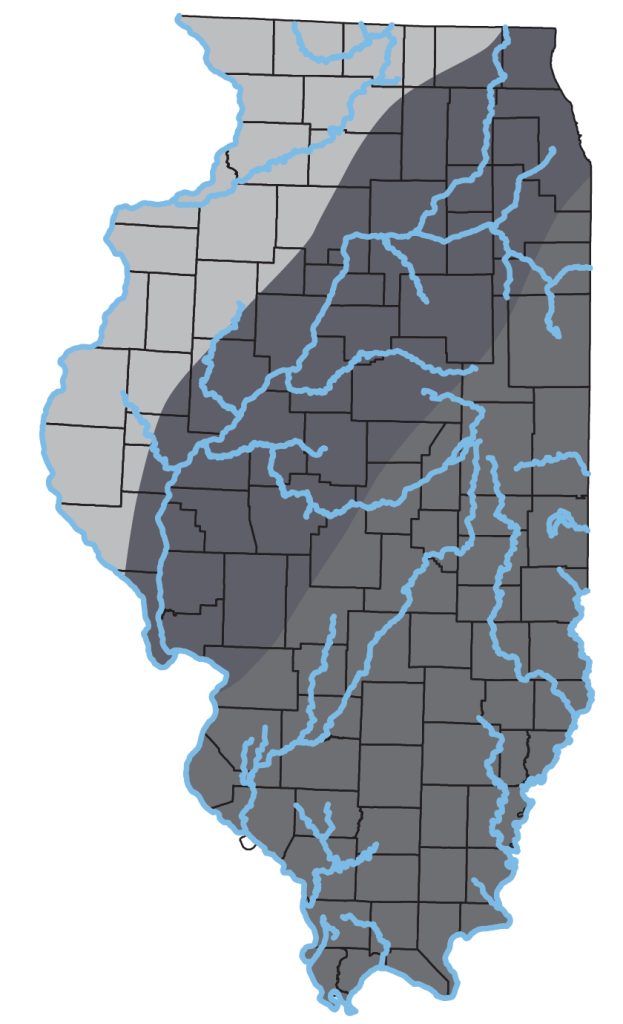Chrysemys picta (Schneider, 1783)

Key Characters: Relatively low, smooth-edged shell; red markings on marginals or plastron; upper jaw with median notch bordered by toothlike cusps.
Similar Species: Slider (melanistic males). See Key to Adult Turtles of Illinois for help with identification.
Subspecies: Smith (1961) recognized the Western Painted Turtle, C. p. bellii (Gray, 1831) and the Midland Painted Turtle, C. p. marginata (Agassiz, 1857) in Illinois; and considered populations in extreme southern Illinois as intergrades between Midland and Southern Painted Turtle, C. p. dorsalis. The latter was tentatively recognized as a full species by Starkey et al. based on mitochondrial DNA (2003. Evolution 57: 119–128). Under this arrangement, all Illinois populations are C. picta, with the exception of extreme southern Illinois in the vicinity of Horseshoe Lake in Alexander County, which has both picta and dorsalis haplotypes.


Description: Medium-sized (up to 18 cm CL) turtle with yellow stripes on head and olive to black carapace. Marginal scutes with vertical bars (bellii) or horizontal to curved markings (marginata); red midback stripe broad (dorsalis), narrow (marginata), or absent (bellii). Plastron: yellow, red, or orange; dark markings broad, laterally branching, and covering most of plastron (bellii); elongated and confined to midplastral seam (marginata); or absent (dorsalis). Extensive intergradation among subspecies produces great variation within Illinois.
Habitat: Frequents most aquatic habitats but most common in shallow, quiet, weedy parts of lakes, ponds, marshes, and river backwaters.
Natural History: Basking congregations are common on logs and banks. Omnivorous diet includes plants, insects, and mollusks. Readily scavenges on dead fish. Nests May to July. Lays 2-3 clutches of 8-9 flexible-shelled, ellipsoidal eggs (ca. 32 x 20 mm). Hatchlings usually overwinter in nest.
Status: Highly adaptable, less susceptible to habitat modification than many turtles. Some collected illegally as pets, but no population appears seriously reduced. Common and widespread.
Etymology: Chrysemys – chrysos (Greek) for gold; emys (Greek) for ‘freshwater tortoise’; picta – pictus (Latin) for painted, colored; bellii – patronym for Thomas Bell (1792-1880); dorsalis – Latin, pertaining to the back.
Original Description: for picta: Schneider, J. 1783. Allgemeine Naturgeschichte der Schildkroten, nebst einem Systematischen Verseichnisse der einzelnen Arten und zwei Kupfern. Muller, Leipzig; for bellii: Gray, J. E. 1831. A synopsis of the species of Class Reptilia. In: Griffith, E & E. Pidgeon: The animal kingdom arranged in conformity with its organisation by the Baron Cuvier with additional descriptions of all the species hither named, and of many before noticed [V Whittaker, Treacher and Co., London: 481 + 110 pp. [1830]; for marginata: Agassiz, Louis 1857. Contributions to the Natural History of the United States of America. vol. 1. Little, Brown & Co., Boston, lii + 452 pp.
Type Specimen: picta: Syntype: MCZ R-1764; belli: Syntype: MCZ; marginata: Syntypes: UIMNH 41529, MCZ 1796, UMMZ.
Type Locality: Not stated
Original Name: Testudo picta Schneider, 1783; Emys bellii Gray, 1831; Chrysemys marginata Agassiz, 1857
Nomenclatural History: The Painted Turtle has a complex nomenclatural history. Of note for Illinois is the subspecies C. p. treleasei, named by Julius Hurter (1911. Herpetology of Missouri. St. Louis Academy of Science Transactions 20(5):59-74) for specimens from Madison, St. Clair, and Monroe counties in Illinois with a red stain on the plastron. This subspecies is no longer recognized. Frank Collins Baker referred to the Painted Turtle in Illinois as C. cinerea (Bonnaterre, 1789). All subspecies in Illinois were referred to the genus Emys at some time in the past.


